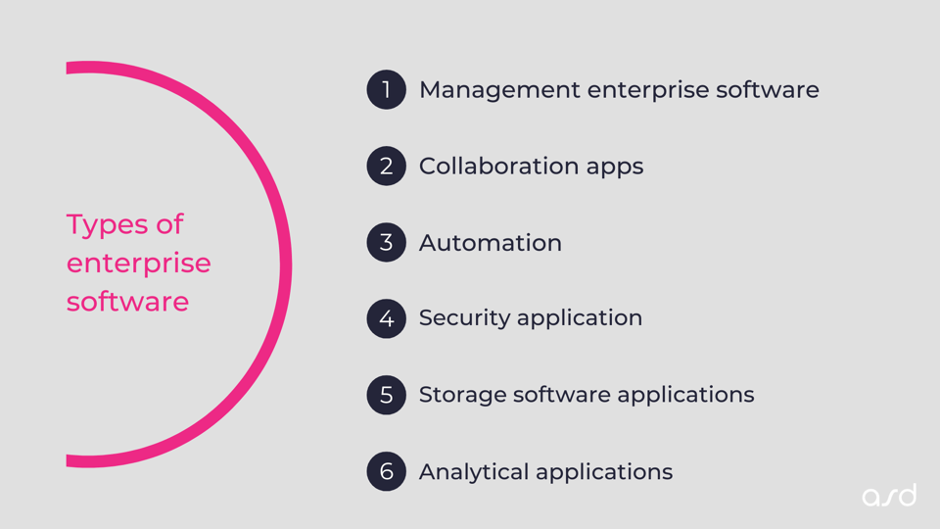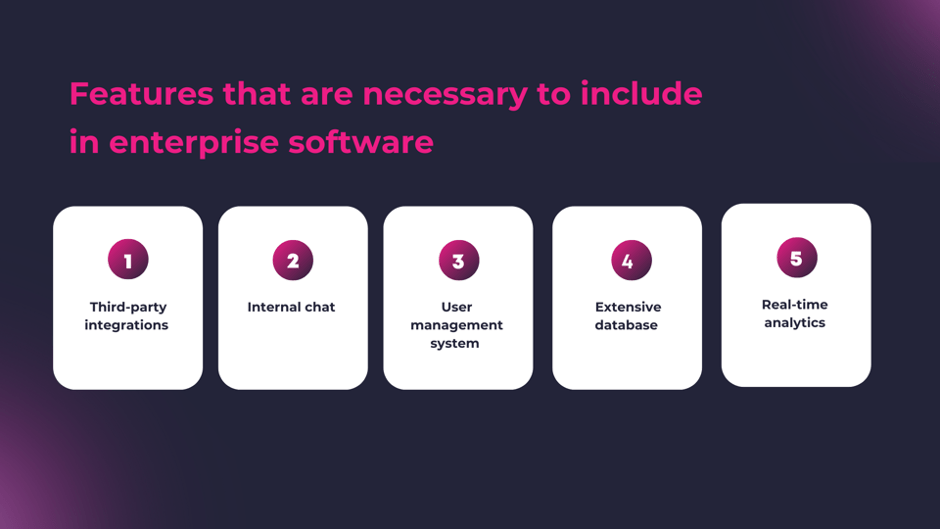How to Build Enterprise Application Properly?
5 minutes read
When a company expands, management becomes more complicated. It is one of the main reasons why enterprise software is becoming popular among large companies. Complicated management requires maximum automation of all the possible processes. Moreover, enterprise software not only automatizes but also optimizes and regularly upgrades processes.
As enterprise software is a vital part of a company. You should responsibly and properly develop it to provide your client with a decent result. That’s why we highly recommend you read the article thoroughly to get all the necessary information about developing enterprise software.
You may also be interested in: How project discovery phase can increase the success rate?
This is the first and the most diverse type of enterprise software, as it offers many services, such as:
A must-have application for a company as it allows workers to collaborate comfortably even at a distance. Applications are flexible and adjustable, and you can build your internal hierarchy with different access levels for each team and its members. The most famous example of a collaboration application is Slack.
The CRM system is also a part of a collaboration application. The system helps to stay in touch with the clients, improve profit and streamline all the processes. content management system, which helps to manage content efficiently.
The more processes are automated, the more profitable they become. Automation reduces manual work by human specialists, and as a result, productivity significantly increases. Such applications can be:
Digital security is vital nowadays as each day threats emerge to digital assets.
The list of security applications contains
Companies have dozens of documents and important data that you need to store somewhere. Storage software applications are the best way to store all the necessary documents in a single place with fast access to them.
For proper decision-making, one must understand the data. That’s why you need analytical applications. The applications read data and process it, so you get a visual representation of the data for a better understanding.

Trends show us the most profitable and proven things in a particular industry. Enterprise software has the following trends:
Software development is a complex process that requires a consecutive approach. Enterprise applications development consists of six stages. Each stage has its irreplaceable purpose that impacts the whole development process. That is why it is crucial to know and implement them all.
Stage 1. Discovery phase.
Before developing something, define what you need, its requirements, and its success criteria.
The Discovery phase includes defining stakeholders, success measures, business goals, and target audience. It is essential to create proper documentation to ensure a smooth and productive development process.
Stage 2. Planning
The planning stage is responsible for outlining all the goals of the development, project roadmap, budget, and tasks. Stakeholders, PM, and BA are working together to create a clear and understandable plan for a smooth development process.
Stage 3. Prototyping and MVP
Prototyping and MVP helps to test the product idea by the test group or the team. During the prototyping of the application, the team analyzes what to improve, add or reject based on the real users’ experience.
Stage 4. Development
It is time for developers to start the development process to create the software. During the development stage developers create all the features and elements of the software to create a ready-to-use product as based on real users reviews that you received in the previous stage.
Stage 5. Testing
Any software and code need testing to reveal and fix all the possible bugs and issues. It is a vital process before the deployment as the product must be polished and ready for use by the target audience.
Stage 6. Deployment and support
After successfully testing the software, it is high time to deploy it. It is not over, as the software requires support, so a team is still working on the software to add necessary features and fix existing bugs or other flaws. Support is also a crucial part of the development process.
More about our software development process, you can read on our webpage.
Third-party integrations
Third-party integrations offer numerous practical solutions for your enterprise application, so implementing integrations is a must-have. Some features are easier and more beneficial to integrate than develop from scratch. More about feature development vs integration is discovered in our previous article.
Internal chat
Workers have to communicate with each other, and it will be better if they can do this within the enterprise application. It is comfortable to have all the work discussions in a single place.
User management system
Each worker in the company has a role, purpose, and specialty. Dividing all of the workers by their roles is the best way to organize work. For example, accountants have their own section within the application without mixing with the office worker’s section.
Extensive database
Enterprise applications work with user data and data transfers, so the database must be proper. Databases should be scalable, secure, and accessible across all platforms and devices.
Real-time analytics
For better data processing, you need real-time analytics. Such a feature makes analyzing the data easier and more understandable, which saves time and effort for more crucial tasks.

To develop proper enterprise software, implement all the crucial features to ensure that the software covers all the company’s needs.
In that case, your clients get a single internal system for their company that will improve productivity and the comfort of the working process.
Our team will contact you within 1 business day. Make sure to check your Spam and Promotions folder just in case.
We use cookies to personalize our services and improve your experience on this website. We may use certain personal data for analytics and marketing purposes.